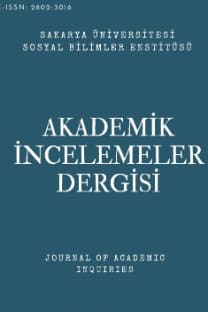Otantik Varoluş Biçiminin Bir Örneği Olarak Körkütük (2020) Filmi: Heideggerci Yaklaşım
Heidegger, Das Man, Dasein, Otantiklik, Körkütük
Druk (2020) Movie as an Example of Authentic Way of Being: A Heideggerian Approach
Das Man, Authenticity, Druk, Heidegger, Dasein,
___
- Audi, Robert (ed.). The Cambridge Dictionary of Philosophy, N.p.: Cambridge University Press, 3rd ed., 2015.
- Dahlstrom, Daniel O. “Heidegger's Method: Philosophical Concepts as Formal Indications”. The Review of Metaphysics 47/4 (1994, June), 775-795.
- Dastur, Françoise. “Logic and Ontology: Heidegger's ‘Destruction’ of Logic”. Research in Phenomenology 17 (1987), 55-74.
- Dreyfus, Hubert L. “Why Heideggerian AI Failed and How Fixing It Would Require Making It More Heideggerian”. Philosophical Psychology 20/2 (2007), 247-268. https://doi.org/10.1080/09515080701239510
- Heidegger, Martin. Being and Time. çev. John Macquarrie - Edward Robinson. Cornwall: Blackwell, 2001.
- Heidegger, Martin. Varlık ve Zaman. çev. Kaan H. Ökten – Alfa Yayınları, 2018.
- Inwood, Michael. A Heidegger Dictionary. Maiden, MA: Blackwell Publishers, 1999.
- Inwood, Michael. Heidegger: A Very Short Introduction. Oxford University Press, 2019.
- Jacquette, Dale (ed.). A Companion to Philosophical Logic. Oxford: Blackwell Publishing, 2006.
- Kant, Immanuel. Critique of Pure Reason. çev. Paul Guyer - Allen Wood. Cambridge: Cambridge University Press, 1999.
- Käufer, Stephan. “Schemata, Hammers, and Time: Heidegger’s Two Derivations of Judgment”. Topoi 22 (2003), 71-93.
- Marcuse, Herbert. Negations: Essays in Critical Theory. çev. Jeremy J. Shapiro. London: MayFlyBooks, 2003.
- Seguna, Josephine A. “Disability: An Embodied Reality (or Space) of ‘Dasein’”. Human Studies 37/1 (2014), 31-56.
- Wheeler, Michael, “Martin Heidegger”, The Stanford Encyclopedia of Philosophy (Fall 2020 Edition), Edward N. Zalta (ed.). Erişim 10 Ocak 2023. https://plato.stanford.edu/archives/fall2020/entries/heidegger/
- Yayın Aralığı: 2
- Başlangıç: 2006
- Yayıncı: Sakarya Üniversitesi Sosyal Bilimler Enstitüsü
Afrika’da Kalkınmacı Devlet: Morityus Mucizesi
Sovyetlerden Günümüze Rus Siyasetinde Renk Sembolizmi (Tarihsel ve Dilbilimsel Perspektif)
Otantik Varoluş Biçiminin Bir Örneği Olarak Körkütük (2020) Filmi: Heideggerci Yaklaşım
Meltem İŞLER SEVİNDİ, Atilla AKALIN
Kürtaj Tartışmaları Bağlamında Örtüşen Görüşbirliğinin Teorik İncelemesi
Sosyo-Politik Gelişmişlik ve Çevre Göstergeleri
1845 Tarihli Temettuat Defterine Göre Ağsaklar/Aksaklar Köyü
Stalin Dönemi (1928-53) Sovyet Tarih Yazımında Türkistan_Orta Asya
Fiyat Arttırma ve Negatif Dengeleme Stratejileri Ekseninde Çin’in Körfez ve Suudi Arabistan Siyaseti
Hüseyin ÇOTUR, Doç. Dr. Bora YENİHAN
Orna Donath. Annelikten Pişman Olmak (çev. Bilge Yalçın). İstanbul: İletişim Yayınları, 2022, 254 s.
